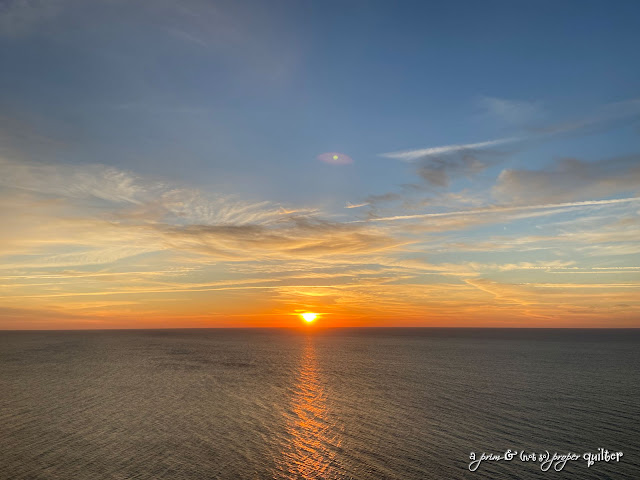Welcome to "Sharing the Process" - Part 1
I finally started the center section of my Stitch & B!tch Sampler.
After completing the roadmap for the Sampler, it sat on the design wall for a month; we left for Myrtle Beach and spent a lovely 10 days there, and the remainder of my vacation was spent doing other things when we returned home. One of my favorite photos from trip:
 |
| Sunrise from our balcony; you can see the moon above |
My birthday was two weeks ago. The day before I spent getting a few more pieces of fabric for the background and a substitute for someone's clothing and ...YARN. More about the yarn in another post. The morning of my birthday I languished in bed until almost noon.
The pattern is from the book, When Quilters Gather by Ruth B. McDowell. I probably selected the most labor-intensive project in the book, but that's how I roll. The book is no longer available from the publisher, but there are used copies out there in the interwebs.
I had spent the weeks before Saturday pulling and piling fabrics and letting them sit on the table to see if they got along. It took me until mid-afternoon Saturday to finally say to myself, “Let’s get this show on the road!”
And that’s the way it is for me; I’m my own worst enemy when starting a project. But the forces in the universe somehow knew it was my birthday and gave me a weekend-long series of showers and storms that ruled out any outdoor activity, and I dove in. I spent all day Sunday in the studio and was amazed with how much I accomplished.
Challenges:
- Working within the confines of my stash;
- Paper piecing (utilizing freezer paper), for which I've never been a huge fan;
- Space - you need to be able to stand back and assess what you've done;
- Time (always, always TIME).
As I said earlier, I did go to a quilt shop last Friday and picked up some fabrics, all for this project (ok, maybe a really cute fabric to make a dress for our great-granddaughter). But everything else came from my stash. I pulled three times what I actually used, but this is only the center panel for the quilt. I know I will be using more of what I've pulled:
In the photo above, the far left pile is what I've used for the center panel. The next 3 piles are what I pulled over the weeks leading to starting the cutting on my birthday. The 2 piles on the right will go back into the stash. The second pile from the left will be used in the quilt construction following the piecing of the panel.
And working within the confines of my stash, it was fun pulling the fabrics (it's always fun pulling fabric). Some of the fabrics are at least 20+ years old.
Funny thought I had while pulling the fabrics; there was a time when I could tell you where and when I purchased every piece. Not so much anymore since it's been almost 30 years since I began quilting. But some of the fabrics pulled for this project I instantly remembered when and where I bought them.
Fast forward to a week following my birthday when I celebrated having cut, auditioned and pinned every piece on the design wall.
So while I may have mentioned that I would “share the process” along the way, I used every chance I had over the week to get to where I am now. This was a conscientious decision after determining while at the beach … again … that life is short and I no longer feel the need to kill myself at work and let it suck out all the joy. That means that every morning prior to starting work and every lunch break this past work week I spent in the studio, and I am amazed at what I accomplished.
And just before we return to our physical office on May 2. Ack.
So enough carrying on, let me tell you my process while working on the panel:
For perspective, the size of this panel is approximately 38" x 45". This is slightly larger than what I had planned because FedEx made an error in printing that I didn’t discover until I returned home with the printed pattern, and I decided to roll with it. This will have an impact on the overall design I had planned, but I’m already thinking of a different layout.
And in the thought of size matters, it really does. For each of the patterns in this book, the author recommends enlarging the pattern by at least a certain percentage and I enlarged it more—and am very glad that I did. There are some teeny tiny pieces in there that if I had used the smaller percentage of enlargement I probably would have been pissed discouraged.
Also, all of the photos below show the fabrics pinned onto the design wall--no piecing has happened yet. You will see what looks like glaring errors; trust me, the seams haven't been sewn and it should look much better once they are sewn.
Back to the roadmap--it has to be cut apart. Each of those lettered and numbered sections have to be carefully cut away from the roadmap, then ironed to the fabric. You cut out your fabrics adding a 1/4" seam allowance on all sides, so that means if you are using one fabric for multiple pieces, you have to ensure you have allowed enough for the seam allowances before you cut.
The pattern is divided into 28 sections, from A to BB. I went in alphabetical order with cutting and that helped me stay on track. The first section, or A, is LeiLani's head:














Comments
Post a Comment